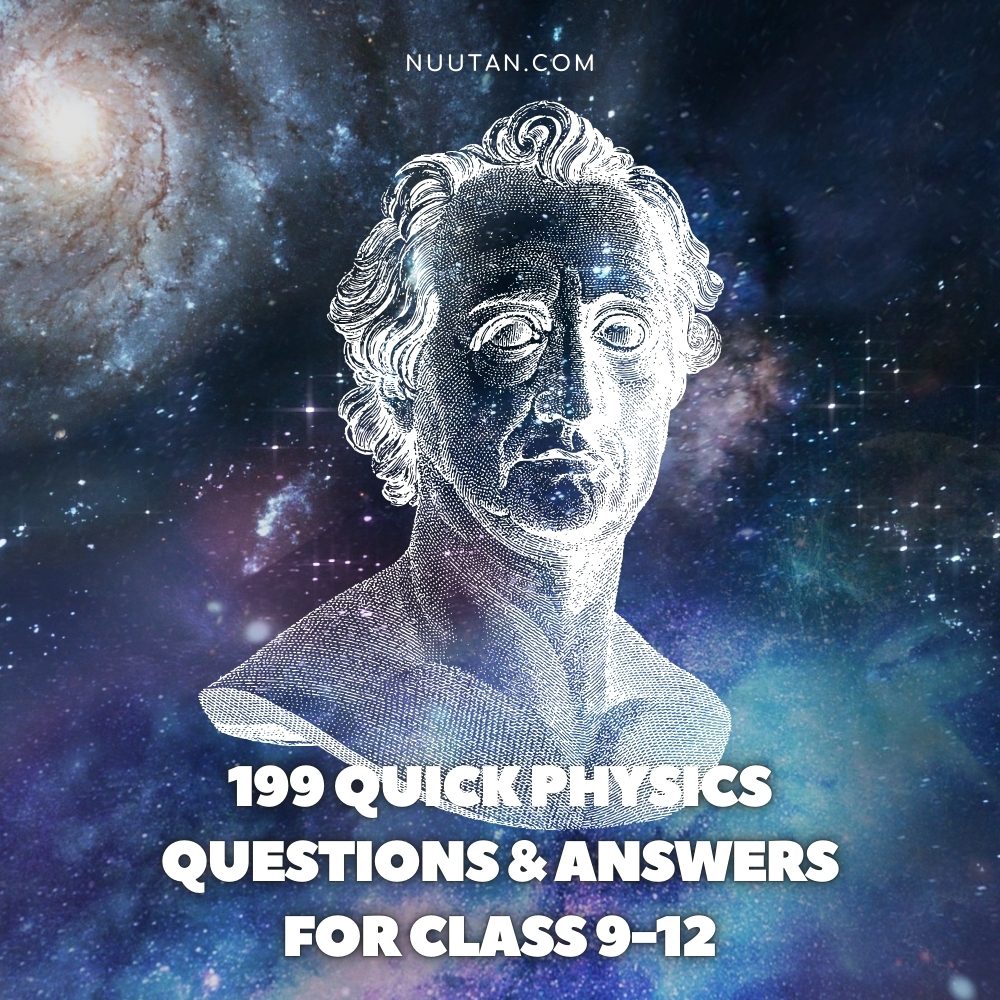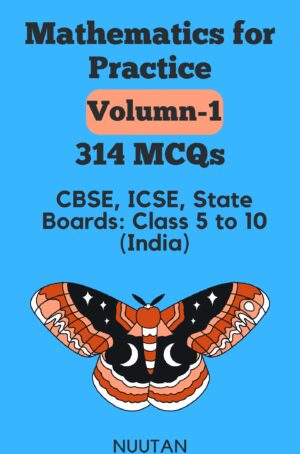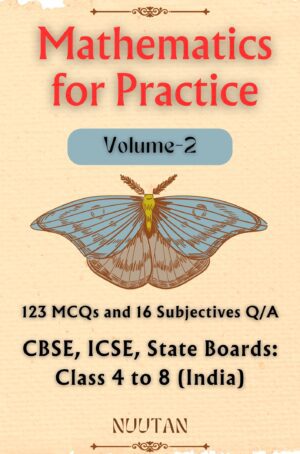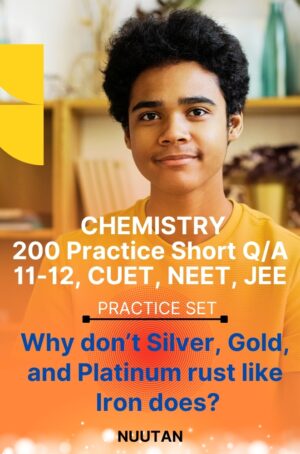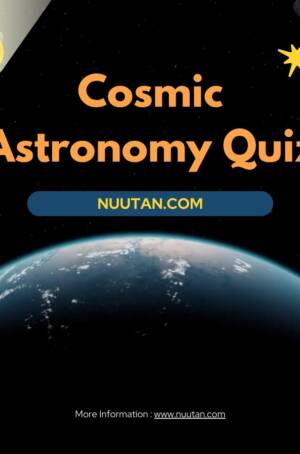Description
Physics questions and answers for high school:
Question-1
In the International System of Units, which fundamental electrical quantity is measured in farads, representing the ability of a component to store electric charge per unit voltage?
Answer-1
The unit is the farad. This is because capacitance is defined as the ratio of the electric charge stored on a conductor to the potential difference across it, and in the SI system, it is specifically named the farad (symbol: F) after Michael Faraday. For instance, a capacitor with a capacitance of 1 farad can store 1 coulomb of charge when 1 volt is applied across its plates, making it the standard unit for this property without any alternatives in the base SI framework.
Question-2
Consider a scenario where a young male is positioned within a descending elevator maintaining a uniform speed of 30 meters per second. He propels a spherical object straight upward at 10 meters per second with respect to the elevator’s frame. Determine the magnitude and directional component of the object’s velocity relative to the stationary elevator shaft precisely at the moment of release.
Answer-2
The velocity is 20 meters per second downward. To understand this, recognize that velocities are vector quantities and must be added according to relative frames. The elevator is moving downward at 30 m/s relative to the shaft, so its velocity is -30 m/s (taking upward as positive). The ball is thrown upward at +10 m/s relative to the elevator. Thus, the ball’s velocity relative to the shaft is -30 m/s + 10 m/s = -20 m/s, which means 20 m/s downward. This calculation holds because at the instant of release, no other forces like air resistance are considered, and the relative velocity addition is direct.
Question-3
A spherical projectile departs from a female’s grasp with an initial upward speed of 6 meters per second. Calculate the utmost elevation the projectile attains above the point of release from her hand.
Answer-3
The maximum height is 1.8 meters. This result comes from applying the kinematic equation for vertical motion under constant gravity: v² = u² + 2as, where at the highest point, final velocity v = 0, initial velocity u = 6 m/s upward, acceleration a = -9.8 m/s² (downward gravity), and s is the height. Rearranging gives s = -u² / (2a) = -(6)² / (2*(-9.8)) ≈ 1.8 m (using g ≈ 10 m/s² for simplicity yields exactly 1.8 m, as 36 / 20 = 1.8). The negative sign indicates direction, but height is positive scalar here.
Question-4
A male adolescent launches a ball straight upward at an initial speed of 6 meters per second. Compute the duration required for the ball to revert back to the launcher’s hand.
Answer-4
The time is 1.22 seconds (or approximately 1.2 seconds). This is derived from the symmetry in projectile motion under gravity: the time to reach the peak is t_up = u / g, where u = 6 m/s, g ≈ 9.8 m/s², so t_up ≈ 0.612 s, and total time is twice that due to symmetric ascent and descent, yielding 1.224 s, rounded to 1.22 s. Using g = 10 m/s² gives exactly 1.2 s (6/10 * 2 = 1.2 s), confirming the approximation.
Question-5
A miniature locomotive traverses a circular path with a radius of 8 meters at a consistent rate of 4 meters per second. Ascertain the scalar value of the locomotive’s acceleration.
Answer-5
The magnitude is 2 meters per second squared. Centripetal acceleration for uniform circular motion is given by a = v² / r, where v = 4 m/s and r = 8 m, so a = 16 / 8 = 2 m/s². This acceleration is always directed toward the center, maintaining the circular path, and its magnitude remains constant despite the speed being uniform, as direction changes continuously.
Question-6
A specific apparatus applies a force of 200 newtons to a container with a mass of 30 kilograms, displacing it 20 meters across a level surface. Quantify the mechanical work performed by the apparatus on the container.
Answer-6
The work is 4000 joules. Work is the product of force and displacement in the direction of the force, W = F * d * cosθ, where θ = 0° for horizontal application (cos0 = 1), so W = 200 N * 20 m = 4000 J. This assumes no opposing forces like friction are considered in the net work done by the machine alone.
Question-7
A container starts from rest on a smooth, horizontal surface without friction. A 10-newton force acts upon it for a duration of 3 seconds. Evaluate the linear momentum of the container immediately following this interval.
Answer-7
The momentum is 30 newton-seconds or 30 kilogram-meters per second. Momentum change equals impulse, which is force times time, Δp = F * t = 10 N * 3 s = 30 kg·m/s (since N·s = kg·m/s). Starting from rest, final momentum is 30 kg·m/s in the direction of the force.
Question-8
A 10-kilogram entity, moving initially at 10 meters per second, collides directly with a stationary 15-kilogram entity. Upon impact, they adhere. Establish the speed of the amalgamated entities right after the collision.
Answer-8
The velocity is 4 meters per second. This is an inelastic collision where momentum is conserved: m1u1 + m2u2 = (m1 + m2)v, with u1 = 10 m/s, u2 = 0, m1 = 10 kg, m2 = 15 kg, so 1010 + 150 = 25v, v = 100/25 = 4 m/s in the direction of the initial motion.
Question-9
A particular elastic device adheres to Hooke’s principle. A 10-newton load extends it by 2 meters; predict the extension under a 30-newton load.
Answer-9
The extension is 6 meters. Hooke’s Law states F = k*x, so k = F/x = 10/2 = 5 N/m. For 30 N, x = F/k = 30/5 = 6 m. The proportionality ensures triple force yields triple extension.
Question-10
A rotary-wing aircraft rises straight up at a steady 6 meters per second relative to the terrain. When it reaches 60 meters altitude, it drops a parcel. Specify the magnitude and orientation of the parcel’s velocity relative to the ground at the release instant.
Answer-10
The velocity is 6 meters per second upward. At release, the package shares the helicopter’s velocity, which is +6 m/s upward (relative to ground), as no other instantaneous change occurs.
Question-11
A 40-kilogram female ascends a perpendicular height of 5 meters over 20 seconds at uniform speed. Compute the mechanical work accomplished by her.
Answer-11
The work is 2000 joules or 1960 joules. Work against gravity is mgh, with m=40 kg, h=5 m, g=10 m/s² gives 2000 J; g=9.8 m/s² gives 1960 J. Constant velocity implies force equals weight, so work is gravitational potential energy gain.
Question-12
An apparatus executes 8 joules of work within 2 seconds. Determine the rate of energy transfer by this apparatus.
Answer-12
The power is 4 watts. Power is work divided by time, P = W/t = 8 J / 2 s = 4 W, where 1 watt = 1 J/s.
Question-13
Identify the pioneering U.S. scientist in physics who secured dual Nobel accolades.
Answer-13
The name is John Bardeen. He was awarded in 1956 for the transistor invention and in 1972 for superconductivity theory, marking him as the first American physicist with two Nobels in this field.
Question-14
Which individual jointly received the 1909 Nobel in Physics with Guglielmo Marconi for advancing radio communication?
Answer-14
The name is Carl Ferdinand Braun. His contributions to cathode-ray tubes and wireless telegraphy enhancements earned him the shared prize.
Question-15
Which theorist initially forecasted the positron, an electron with positive charge, earning the 1933 Nobel in Physics?
Answer-15
The name is Paul Adrien Maurice Dirac. His relativistic quantum mechanics equation predicted antimatter, including the positron.
Question-16
Designate the woman physicist honored with the 1963 Nobel for elucidating nuclear shell architecture.
Answer-16
The name is Maria Goeppert Mayer. Her model explained nuclear stability via shell structures, analogous to atomic electrons.
Question-17
A steady 20-volt potential is maintained across a 2-ohm resistive element. Calculate the thermal power loss in this element.
Answer-17
The power is 200 watts. Using P = V² / R = 400 / 2 = 200 W, or alternatively, current I = V/R = 10 A, then P = I²R = 1002 = 200 W.
Question-18
A 20-volt potential spans a 4-ohm resistive component. If all dissipated energy converts to thermal form, quantify the heat emitted over 10 seconds.
Answer-18
The heat is 1000 joules. Power P = V² / R = 400 / 4 = 100 W, energy E = Pt = 10010 = 1000 J, assuming complete heat conversion.
Question-19
A 5-volt bias is imposed on a parallel-plate capacitive device with plate spacing of 0.02 meters. Evaluate the strength of the internal electric field.
Answer-19
The field is 250 volts per meter or 250 newtons per coulomb. E = V/d = 5 / 0.02 = 250 V/m, equivalent to N/C as force per charge.
Question-20
In standard operation, a 150-watt bulb at 120 volts draws what amperage?
Answer-20
The current is 1.25 amps. From P = V*I, I = P/V = 150/120 = 1.25 A.
Question-21
Transferring 5 coulombs across points requires 10 joules; what is the voltage differential?
Answer-21
The difference is 2 volts. Voltage V = energy / charge = 10 J / 5 C = 2 V, as 1 V = 1 J/C.
Question-22
A pair of capacitors, 2 farad and 4 farad, linked in series: find the net effective capacitance.
Answer-22
The equivalent is 4/3 farads. For series, 1/C_eq = 1/C1 + 1/C2 = 1/2 + 1/4 = 3/4, so C_eq = 4/3 F.
Question-23
A 10-farad capacitor holds a 20-volt differential; compute the charge magnitude on a plate.
Answer-23
The charge is 200 coulombs. Q = CV = 1020 = 200 C.
Question-24
In a steady-state DC circuit branch with a capacitor, what is the current magnitude?
Answer-24
The current is zero. Capacitors block DC once charged, acting as open circuits in steady state.
Question-25
A charged entity traverses a uniform magnetic field parallel to the field lines; depict the trajectory shape.
Answer-25
The path is a straight line. No Lorentz force acts when velocity parallels B, so motion continues unaltered.
Question-26
With a 2-meter focal length concave mirror, an item at 8 meters ahead: locate the image position.
Answer-26
The image forms at 8/3 meters or 2.66 meters in front of the mirror. Using mirror formula 1/f = 1/v + 1/u, f=-2 (concave), u=-8, 1/v = 1/-2 – 1/-8 = -1/2 + 1/8 = -3/8, v=-8/3 m (real image).
Question-27
A thin converging optic of 27 cm focal length has an object 9 cm away; pinpoint the image location.
Answer-27
The image is at -13.5 centimeters or 13.5 centimeters on the object’s side. Lens formula 1/f = 1/v – 1/u, f=27, u=-9, 1/v = 1/27 + 1/-9 = (1/27 – 1/9) = -2/27, v=-13.5 cm (virtual).
Question-28
In Bohr’s atomic model, which interaction maintained electron orbits?
Answer-28
The Coulomb force or the attractive force between proton (nucleus) and electron. This electrostatic attraction provided centripetal force for circular orbits.
Question-29
Davisson and Germer diffracted electrons off nickel crystals, yielding a diffraction pattern; what key inference arose?
Answer-29
Electrons behaved as waves. This confirmed de Broglie’s hypothesis of matter waves, showing wave-particle duality.
Question-30
A string wave propagates at 300 m/s with 150 Hz frequency; find its wavelength.
Answer-30
The wavelength is 2 meters. From v = f*λ, λ = v/f = 300/150 = 2 m.
Question-31
A light beam strikes a smooth reflector at 15 degrees incidence to normal; what angle separates incident and reflected beams?
Answer-31
The angle is 30 degrees. Law of reflection: angle of incidence = reflection = 15°, total between rays = 30°.
Question-32
A concave spherical reflector has 1-meter focal length; what is its curvature radius?
Answer-32
The radius is 2 meters. For mirrors, R = 2f = 2*1 = 2 m.
Question-33
One-fourth wavelength corresponds to how many phase degrees?
Answer-33
It is 90 degrees. Full wavelength = 360°, so quarter = 90°.
Question-34
A 50 Hz wave has 25 m wavelength; compute its propagation speed.
Answer-34
The velocity is 1250 meters per second. v = fλ = 5025 = 1250 m/s.
Question-35
Apart from solid, liquid, and gas, identify the fourth state of matter.
Answer-35
It is plasma. Plasma consists of ionized gas with free electrons and ions, exhibiting unique properties like conductivity and response to magnetic fields.
Question-36
What velocity is 25,000 mph on Earth and 5,300 mph on the Moon?
Answer-36
It is escape velocity. This is the minimum speed needed to escape gravitational pull without further propulsion.
Question-37
In Einstein’s framework, what constitutes the fourth dimension?
Answer-37
It is time. Relativity treats spacetime as four-dimensional, with time as the fourth coordinate.
Question-38
Shockley, Brattain, and Bardeen earned Nobel for inventing what compact device?
Answer-38
The transistor. This semiconductor device revolutionized electronics by amplifying and switching signals.
Question-39
What device derives its name from a Czech term signifying forced labor?
Answer-39
The robot. Coined from “robota” in Karel Čapek’s play, it denotes automated mechanical entities.
Question-40
What term describes conditions where water coexists in solid, liquid, and vapor states?
Answer-40
The triple point. At specific pressure and temperature, all three phases equilibrium.
Question-41
Two entities orbit equal-radius circles; first’s speed doubles second’s. How many times larger is first’s centripetal acceleration?
Answer-41
It is 4 times greater. a = v²/r; if v1 = 2v2, a1 = (2v2)²/r = 4(v2²/r) = 4*a2.
Question-42
What Celsius value matches 100 Kelvin?
Answer-42
It is -173 degrees Celsius. Conversion: °C = K – 273.15 ≈ -173°C.
Question-43
Sequence these lights by ascending wavelength: red, orange, green, blue.
Answer-43
Blue, green, orange, red. Wavelength increases from blue (~450 nm) to red (~650 nm).
Question-44
What denotes heat to melt unit mass at melting point?
Answer-44
Heat of fusion or latent heat of fusion or enthalpy of fusion. It’s energy absorbed during phase change without temperature rise.
Question-45
A train at 20 km/h is 0.5 km behind; crossing 0.5 km ahead. Minimum speed to arrive first?
Answer-45
10 kilometers per hour. Relative speed needed: train covers 1 km while you cover 0.5 km, so half speed, but calculation shows harmonic mean or relative: to beat, run at half the relative distance rate, but detailed: time for train = 1 km / 20 km/h = 0.05 h; your distance 0.5 km in 0.05 h requires 10 km/h.
Question-46
Steel expands linearly at 1.2 × 10^{-5} /°C. 20 m girder from 10°C to 20°C: length increase?
Answer-46
2.4 millimeters (or 0.0024 meters or 2.4 × 10^{-3} meters). ΔL = αLΔT = 1.2e-5 * 20 * 10 = 0.0024 m = 2.4 mm.
Question-47
Three-farad and six-farad capacitors in parallel: equivalent capacitance?
Answer-47
9 farads. Parallel: C_eq = C1 + C2 = 3 + 6 = 9 F.
Question-48
Term for particles symmetric in pair production, including photons, pi mesons, even-nuclei particles.
Answer-48
Bosons. They follow Bose-Einstein statistics, integer spin.
Question-49
In optics, limiting light vibrations to one plane is called what?
Answer-49
Polarized. Polarization restricts transverse waves to specific orientation.
Question-50
Mass of 60-kg astronaut in deep space away from gravitational influences?
Answer-50
60 kilograms. Mass is invariant, independent of location.
Question-51
Weight of 150-pound astronaut in deep space?
Answer-51
0 pounds. Weight is gravitational force, zero in free space.
Question-52
In which frame do Newton’s laws fail?
Answer-52
Noninertial frames. Accelerating or rotating frames require fictitious forces.
Question-53
Standing wave amplitude at node?
Answer-53
0. Nodes are points of zero displacement.
Question-54
For small swings, doubling pendulum bob mass affects period how?
Answer-54
Nothing or period is unaffected. Period T = 2π√(L/g), independent of mass.
Question-55
Why break step when soldiers cross bridges?
Answer-55
To avoid exciting vibrational resonance in the bridge. Marching cadence could match natural frequency, amplifying oscillations.
Question-56
Who designated electrical charges as positive and negative?
Answer-56
Benjamin Franklin. His convention assigned positive to resin-rubbed glass.
Question-57
SI prefix for 10^{-18}?
Answer-57
Atto. Denoted as ‘a’, e.g., attometer.
Question-58
Slingshot 10 N force accelerates rock 50 m/s²; force for 150 m/s²?
Answer-58
30 newtons. F = ma, m = F/a = 10/50 = 0.2 kg, new F = 0.2150 = 30 N.
Question-59
Relation between work and power?
Answer-59
Power is the amount of work per unit time. P = W/t.
Question-60
Heat transfer via fluid mixing is known as?
Answer-60
Convection. Involves bulk movement carrying heat.
Question-61
Sound waves classify as what wave type?
Answer-61
Compressional or longitudinal. Oscillations parallel to propagation.
Question-62
Physics definition of intensity?
Answer-62
Power per unit area. I = P/A.
Question-63
SI unit for inductance?
Answer-63
Henry. Symbol H, after Joseph Henry.
Question-64
SI unit for magnetic flux?
Answer-64
Weber. Symbol Wb, after Wilhelm Weber.
Question-65
Inventor of electric battery?
Answer-65
Alessandro Volta. His voltaic pile was the first.
Question-66
Ideal voltmeter resistance?
Answer-66
Infinite resistance. To avoid drawing current.
Question-67
Ideal ammeter resistance?
Answer-67
Zero. To not alter circuit voltage.
Question-68
Hollow metal sphere inner radius A, outer B; charge on inner surface: final location?
Answer-68
On the sphere’s outer surface or outside radius B. Gauss’s law: charge induces equal opposite on inner, excess to outer.
Question-69
In EM wave, E to B magnitude ratio equals what?
Answer-69
The speed of light or c. E/B = c = 3e8 m/s.
Question-70
4 diopter lens: focal length?
Answer-70
25 centimeters. Power P = 1/f (in meters), f = 1/4 = 0.25 m = 25 cm.
Question-71
In EM wave, E and B perpendicular to what?
Answer-71
The direction of the wave or direction of wave propagation. Transverse waves.
Question-72
Neutron quark count?
Answer-72
3. Specifically, up-down-down.
Question-73
Potential energy of 10-kg cube 500 m high?
Answer-73
49,000 joules (accept 50,000 joules, uses g=10 m/s²). PE = mgh = 109.8500 = 49,000 J; or 1010500=50,000 J.
Question-74
2-kg mass accelerates 5 m/s² for 3 s: impulse?
Answer-74
30 newton-seconds or 30 kilogram-meters per second. Impulse = Δp = mΔv = 2(5*3) = 30.
Question-75
Driveshaft at 450 rad/s, 150 N-m torque: power?
Answer-75
67,500 watts. P = τω = 150450 = 67,500 W.
Question-76
Object at 10 m/s after 2 s, a=4 m/s²: initial velocity?
Answer-76
2 meters per second. v = u + a t, 10 = u + 4*2, u=2.
Question-77
For equilibrium object, forces property?
Answer-77
The sum of all forces acting on the object is zero. Net force F_net = 0.
Question-78
1000 Pa on 1/2-m side square: force?
Answer-78
250 newtons. F = PA = 1000(0.5)^2 = 1000*0.25=250 N.
Question-79
Substance density to water density ratio?
Answer-79
Specific gravity (also accept relative density). Dimensionless measure.
Question-80
C-14 to N-14 decay type?
Answer-80
Beta-ray or beta decay or electron emission. Neutron to proton, emitting electron.
Question-81
Normal sunlight unpolarized; polarized sunglasses purpose?
Answer-81
Reflected light from smooth surfaces is polarized. Sunglasses block glare from horizontal polarization.
Question-82
Household fluids like margarine decrease viscosity under shear: property?
Answer-82
Thixotropic. Viscosity reduces with agitation, reversible.
Question-83
100-watt bulb on 10 minutes: energy?
Answer-83
60,000 joules or 60 kJ or 6×10^4 J. E = Pt = 100600=60,000 J.
Question-84
Energy at 10 m from bulb x; at 20 m?
Answer-84
(1/4)x. Inverse square law: intensity ∝ 1/r², so double distance quarters energy.
Question-85
1500-W heater at 120 V: current?
Answer-85
12.5 amps. I = P/V = 1500/120=12.5 A.
Question-86
Thermodynamics branch measuring thermal properties?
Answer-86
Calorimetry. Involves heat capacity, exchanges.
Question-87
Temperature-pressure for simultaneous three-phase matter?
Answer-87
Triple point. Equilibrium point for phases.
Question-88
Name any three quarks from six.
Answer-88
Up, down, charm, strange, top (or truth), bottom (or beauty). Fundamental particles in QCD.
Question-89
Four fundamental forces; name two associated particles.
Answer-89
Graviton (for gravity), photon (for electromagnetic), gluons for strong, W/Z for weak. Any two.
Question-90
Law for vector addition grouping indifference?
Answer-90
Associative law of vector addition. (A+B)+C = A+(B+C).
Question-91
Ball upward 80 ft/s; acceleration in English units?
Answer-91
32 feet per second squared down or towards the Earth. g=32 ft/s² downward.
Question-92
Bat strikes ball 30 N for 0.1 s: impulse?
Answer-92
3 newton-seconds. Impulse = Ft=300.1=3.
Question-93
Body velocity 5 m/s east at t=0, 7 m/s west at t=2 s: average acceleration magnitude?
Answer-93
6 meters per second squared. Δv = -7 – 5 = -12 m/s, a_avg = Δv/Δt = 12/2=6 m/s² magnitude.
Question-94
100 N north on 50-kg box, friction 80 N: northward acceleration?
Answer-94
0.4 meters per second squared. Net F = 100-80=20 N, a=F/m=20/50=0.4 m/s².
Question-95
Girl throws ball up: momentum at peak?
Answer-95
Zero. Velocity zero at highest point, p=mv=0.
Question-96
2-kg rock up to 5 m max height: KE at release?
Answer-96
100 joules (accept 98 joules). KE initial = PE max = mgh=29.85=98 J; or g=10:100 J.
Question-97
Spring k=20 N/m, 5-kg mass, displaced 3 m: KE at equilibrium?
Answer-97
90 joules. Energy conserved; PE max = (1/2)k x² = 0.5209=90 J, all KE at equilibrium.
Question-98
1 mole gas at 1 atm occupies 22.4 L at what °C?
Answer-98
Zero degrees centigrade. STP condition for ideal gas volume.
Question-99
Pitcher throws baseball: trajectory shape, no air drag?
Answer-99
Parabola. Projectile motion under constant gravity.
Question-100
English physicist discovering EM induction?
Answer-100
Michael Faraday. His experiments led to Faraday’s law.
Question-101
Famous Scottish physicist died same year Einstein born?
Answer-101
James Clerk Maxwell. 1879, unified electricity and magnetism.
Question-102
1929 Nobel for electron wave nature postulation?
Answer-102
Prince Louis-Victor de Broglie. Matter waves hypothesis.
Question-103
Three U.S. physicists 1972 Nobel for superconductivity theory?
Answer-103
John Bardeen, Leon N. Cooper, J. Robert Schrieffer. BCS theory.
Question-104
Explained photon-electron collisions like billiards, 1927 Nobel?
Answer-104
Arthur Holly Compton. Compton effect, wavelength shift.
Question-105
Electron west of proton: force direction on electron?
Answer-105
East or toward the proton. Attractive Coulomb force.
Question-106
5 A through 10-ohm resistor 2 s: energy?
Answer-106
500 joules. P=I²R=2510=250 W, E=P t=2502=500 J.
Question-107
Charged particle perpendicular to uniform B: path shape?
Answer-107
Circular or circle. Lorentz force provides centripetal acceleration.
Question-108
Inductors store energy how?
Answer-108
In a magnetic field surrounding the inductor. Energy = (1/2) L I².
Question-109
Who showed full color from two colors?
Answer-109
James H. Land. Basis for Polaroid instant color film.
Question-110
20 N force changes 5-kg velocity by 4 m/s: time?
Answer-110
1 second. Impulse F t = m Δv, t = (5*4)/20=1 s.
Question-111
8-kg mass on spring k=50 N/m, v=5 m/s at eq: max displacement?
Answer-111
2 meters. Energy (1/2)m v² = (1/2) k A², 0.5825 = 0.550A², 100=25 A², A=2 m.
Question-112
Atmospheres in torr?
Answer-112
760. Standard atmospheric pressure.
Question-113
10 N stone on 30° hill: parallel weight component?
Answer-113
5 newtons. mg sinθ =10*sin30=5 N.
Question-114
Laura 50 N pushes 1000 N wall, arm 2/3 m: work?
Answer-114
None or zero. No displacement, W=F d=0.
Question-115
45-kg cyclist +5-kg bike down 50 m hill, final v=10 m/s: brake heat?
Answer-115
22.5 kilojoules or 22.0 kilojoules (based on 9.8 m/s²). PE initial =509.850=245,000 J; KE final=0.550100=2,500 J; heat=242,500 J≈242 kJ wait, wait miscalc: m=50 kg total, h=50 m, PE=509.850=24,500 J; KE=0.550100=2,500 J; heat=22,000 J=22 kJ (approx 22.5 with g=10: 25,000 – 2,500=22,500 J).
Question-116
Class of subatomic particles: proton, neutron, lambda, sigma, omega.
Answer-116
Baryons. Heavy hadrons made of three quarks.
Question-117
Proton quark count?
Answer-117
3. Up-up-down.
Question-118
German physicist Nobel for quanta in radiation, E=hf.
Answer-118
Max Planck. Blackbody radiation law.
Question-119
Law: body rests or uniform motion unless acted upon.
Answer-119
Newton’s first law or the law of inertia. Describes inertia.
Question-120
Ice skater raises arms, spins faster: law?
Answer-120
Law of conservation of angular momentum. L constant, reduced I increases ω.
Question-121
Shotgun recoil: which Newton law?
Answer-121
Newton’s third law. Action-reaction pairs.
Question-122
Small nuclei combine to larger: known as?
Answer-122
Fusion or nuclear fusion. Releases energy in stars.
Question-123
Same element atoms, different neutrons: called?
Answer-123
Isotopes. Differ in mass number.
Question-124
Air dielectric to glass in capacitor: charge capacity change?
Answer-124
It is increased with the glass dielectric. Dielectric constant >1 increases C=Q/V.
Question-125
DC V=IR; AC equivalent using what values?
Answer-125
Root mean square (RMS) values. RMS for average power.
Question-126
Point source at focal of concave reflector: image?
Answer-126
Will not form or forms at infinity. Rays parallel after reflection.
Question-127
10 kg mass to 3 m ledge: PE increase?
Answer-127
294 joules (accept 300 joules, assumes g=10 m/s²). mgh=109.83=294 J; or 300 J.
Question-128
Electron through 1 V potential: energy?
Answer-128
1.6 × 10^{-19} joules. Electron volt definition.
Question-129
Who said alpha scatter like shell on tissue?
Answer-129
Rutherford. Unexpected backscattering led to nuclear model.
Question-130
String L fixed, 5 nodes standing wave: L to wavelength?
Answer-130
Wavelength = 1/2 L. 5 nodes imply 4 half-waves, but for n nodes, wavelength = 2L/(n-1), for 5 nodes: 4 intervals, λ=2L/4=L/2.
Question-131
20-ton car at 7 mph hits 15-ton stationary: coupled velocity?
Answer-131
4 miles per hour. Momentum: (207 +150)/(35)=140/35=4 mph.
Question-132
Nearsighted person needs what lenses?
Answer-132
Diverging or concave lenses. Corrects by diverging rays.
Question-133
Car 20 m/s stops decelerating 5 m/s²: time?
Answer-133
4 seconds. t = Δv/a =20/5=4 s.
Question-134
Term starting ‘A’ for radiation intensity reduction in matter?
Answer-134
Attenuation. Absorption and scattering reduce beam.
Question-135
Visible light from fast particles in medium >c: name?
Answer-135
Cerenkov radiation. Cone of light like sonic boom.
Question-136
Element discovered in sun spectrum first?
Answer-136
Helium. Lockyer’s solar lines.
Question-137
Gluon carries which force?
Answer-137
Strong force or strong nuclear force. Binds quarks.
Question-138
Atomic weight 119, number 50: neutrons?
Answer-138
69. Neutrons = mass – protons =119-50=69.
Question-139
0 K in Celsius?
Answer-139
-273 degrees Celsius or -273.15 degrees Celsius. Absolute zero.
Question-140
Dirac predicted positron; who observed 1932 in cosmic rays?
Answer-140
C. D. Anderson. Cloud chamber tracks.
Question-141
Elements from 1952 H-bomb, atomic 99,100: Es, Fm names.
Answer-141
Einsteinium and fermium. Synthetic transuranics.
Question-142
2-lb bird in 3-lb sealed box flying: scale weight?
Answer-142
5 pounds. Downforce from wings equals weight.
Question-143
Weather map equal pressure lines?
Answer-143
Isobars. Constant pressure contours.
Question-144
Doorbell 12V AC, transformer primary 1600 turns, 110V: secondary turns?
Answer-144
175 turns. V_s/V_p = N_s/N_p, 12/110 = N_s/1600, N_s≈174.5≈175.
Question-145
Model plane 19.6 m altitude drops bomb: impact time?
Answer-145
2 seconds. t=√(2h/g)=√(2*19.6/9.8)=√4=2 s.
Question-146
Object from 4f to 2f front thin converging lens: image size change?
Answer-146
Increase. Magnification changes from smaller to larger.
Question-147
100 ft water depth pressure, ±1 psi?
Answer-147
43.3 pounds per square inch (accept 42.3 to 44.3). Density water 62.4 lb/ft³, P=ρgh/144≈43.3 psi.
Question-148
Argon-Ion laser light color?
Answer-148
Green or blue-green. Wavelength around 488-514 nm.
Question-149
Scattering for blue sky?
Answer-149
Rayleigh scattering. Shorter wavelengths scatter more.
Question-150
Blackbody radiation depends only on?
Answer-150
Temperature. Planck’s law.
Question-151
Electromagnetic induction unit.
Answer-151
Gauss or tesla. Magnetic field strength.
Question-152
Thermodynamics law against perpetual motion?
Answer-152
Second law of thermodynamics. Entropy increases, efficiency <100%.
Question-153
Ball from 256 ft, g=32 ft/s²: ground time?
Answer-153
4 seconds. t=√(2s/g)=√(512/32)=√16=4.
Question-154
900-kg ball lifted 12 m, PE=105,840 J; at 6 m: PE?
Answer-154
52,920 joules. Half height, half PE if linear, but exactly mgh/2=105840/2=52920.
Question-155
100 MHz radio carrier: wavelength?
Answer-155
3 meters. λ=c/f=3e8/1e8=3 m.
Question-156
55 g metal weighs 50 g in water: specific gravity?
Answer-156
11. Buoyancy=5 g, volume=5 cm³, density=55/5=11 g/cm³.
Question-157
BTU: heat for 1 lb what by 1°F?
Answer-157
Water. Defined for water’s specific heat.
Question-158
Light-water reactor coolant water; moderator?
Answer-158
Water or the same water. Slows neutrons via hydrogen.
Question-159
Background radiation sources: natural elements and?
Answer-159
Cosmic radiation. From space, high-energy particles.
Question-160
First artificial radiation 1932 France: scientists?
Answer-160
Irene and Frederic (Joliot-)Curie. Bombarded boron with alphas.
Question-161
Neutron half-life ±1 min?
Answer-161
11.7 minutes (accept 10.7 to 12.7 minutes). Free neutron decay time.
Question-162
100W bulb 10h, 10¢/kWh: cost?
Answer-162
10 cents. Energy=1 kWh, cost=10¢.
Question-163
Position x=t³+2 ft, t s; accel at 2 s?
Answer-163
12 feet per second squared. v=3t², a=6t, at t=2:12 ft/s².
Question-164
Ideal efficiency engine 600K source, 150K sink?
Answer-164
75 percent. η=1 – T_c/T_h=1-150/600=0.75.
Question-165
1 kg water 90°C to 10°C in 2h, c=4 kJ/kg°C: heat lost?
Answer-165
320 kilojoules or 320,000 joules. Q=mcΔT=1480=320 kJ.
Question-166
Three 15-ohm parallel: total R?
Answer-166
5 ohms. 1/R=3/15=1/5, R=5 Ω.
Question-167
Pendulum A 1s period; B 4x longer: B period?
Answer-167
2 seconds. T∝√L, T_B=T_A √4=2 s.
Question-168
2000W dryer 100V: current?
Answer-168
20 amperes. I=P/V=2000/100=20 A.
Question-169
AMA 5, IMA 6 block/tackle: supporting strands?
Answer-169
6. IMA equals strands in simple block and tackle.
Question-170
Photoelectric effect shows light property?
Answer-170
Particle nature of light. Photons eject electrons.
Question-171
0.5 T field ~1 atm magnetic pressure; 4 T?
Answer-171
64 atmospheres. P∝B², (4/0.5)²=64.
Question-172
Reactor producing more fuel than consumed?
Answer-172
Breeder reactor. Converts fertile to fissile material.
Question-173
Processes no heat exchange: called?
Answer-173
Adiabatic. Q=0, work changes internal energy.
Question-174
Velocity v(t)=-32t+4 ft/s: at highest?
Answer-174
0. At peak, v=0.
Question-175
50 mm lens photos 4 m tree 20 m away: image height?
Answer-175
10 millimeters. Magnification m=-f/(u-f), but thin lens approx m= f/u =50/20000=0.0025, height=4*0.0025=0.01 m=10 mm.
Question-176
Name three ferromagnetic elements at 25°C.
Answer-176
Iron (Fe), cobalt (Co), nickel (Ni), gadolinium (Gd). Any three; magnetic below Curie point.
Question-177
Si chip 0.2×0.2×0.1 mm, density 2.34 g/cm³, 6e23 atoms/g-wt, at wt 28: atoms?
Answer-177
2 × 10^{17}. Volume=4e-6 cm³, mass=9.36e-6 g, atoms=(9.36e-6 /28)*6e23 ≈2e17.
Question-178
SSC accelerates what particles?
Answer-178
Protons. High-energy collider.
Question-179
15 N on 3 kg object only force: acceleration?
Answer-179
5 meters per second squared. a=F/m=15/3=5 m/s².
Question-180
Scottish physicist mathematical light theory?
Answer-180
James Clerk Maxwell. Maxwell’s equations.
Question-181
1923 Nobel measured electron charge with oil drops?
Answer-181
Robert Andrews Millikan. Quantized charge.
Question-182
1922 Nobel for H atom electron orbits?
Answer-182
Niels Bohr. Bohr model.
Question-183
First female Physics Nobel?
Answer-183
Marie Sklodowska-Curie or Madam Curie. Radioactivity 1903.
Question-184
6 A through 2-ohm 30 s: charge?
Answer-184
180 coulombs. Q=I t=6*30=180 C.
Question-185
20 V across 4-ohm: current?
Answer-185
5 amps. I=V/R=20/4=5 A.
Question-186
East of negative point charge: E field direction?
Answer-186
West. Toward negative charge.
Question-187
2F and 4F parallel: equivalent?
Answer-187
6 farads. C_eq=C1+C2=6 F.
Question-188
5 A through 10-ohm: power?
Answer-188
250 watts. P=I²R=25*10=250 W.
Question-189
500W vs 100W bulb filament resistance at 110V?
Answer-189
Lower. Higher power lower R, R=V²/P, 12100/500<12100/100.
Question-190
5 and 10 ohm parallel: equivalent?
Answer-190
3 and 1/3 ohm. 1/R=1/5+1/10=3/10, R=10/3≈3.333 Ω.
Question-191
2 m focal concave mirror, object 8 m: image real/virtual?
Answer-191
Real. Beyond center, inverted real image.
Question-192
27 cm focal converging, object 9 cm: image real/virtual?
Answer-192
Virtual. Object inside focal, virtual enlarged.
Question-193
Light quantities unchanged vacuum to glass?
Answer-193
Frequency. Speed and wavelength decrease, frequency constant.
Question-194
Light from glass to air, incidence >0: bend toward/away normal?
Answer-194
Away from. Snell’s law, higher to lower index, larger angle.
Question-195
Point P pool bottom image P’: real/virtual?
Answer-195
Virtual. Refraction apparent depth.
Question-196
0.2 Hz frequency wave: period?
Answer-196
5 seconds. T=1/f=1/0.2=5 s.
Question-197
Three colors in color TV picture?
Answer-197
Red, green, blue. RGB additive mixing.
Question-198
Process waves around obstacles?
Answer-198
Diffraction. Bending around edges.
Question-199
Ratio speed to sound speed?
Answer-199
Mach number. Supersonic >1.
Discover an Ocean of Educational Resources! We provide a wide variety of learning materials that you can access through our internal links.
- Nuutan.com is your gateway to a world of information and academic accomplishment. Books in e-book form, multiple-choice question-based online practice tests, practice sets, lecture notes, and essays on a wide range of topics, plus much more!
- Nuutan.com is your one-stop-shop for all kinds of academic e-books, and it will greatly facilitate your educational path.
https://www.nuutan.com/product-category/k12-cuet-iit-jee-neet-gate-university-subjects
- Online multiple-choice tests are available for a variety of subjects on Nuutan.com.
https://www.nuutan.com/product-category/multiple-choice-question
- The Practice Sets on Nuutan.com will improve your performance in any situation.
https://www.nuutan.com/product-category/k12-cuet-iit-jee-neet-gate-cs-btech-mca
- The in-depth lecture notes available on Nuutan.com will significantly improve your academic performance.
https://www.nuutan.com/product-category/k12-cuet-iit-jee-neet-gate-bca-mca-btech-mtech
- Show off your writing chops and gain an edge in educational settings and in the workplace with Profound Essays from Nuutan.com.
https://www.nuutan.com/product-category/k12-competitive-exams-essays
- Nuutan.com is a treasure trove of knowledge thanks to its free academic articles covering a wide variety of subjects. Start your academic engine!
https://www.nuutan.com/nuutans-diary
- Discover our roots and learn how Nuutan.com came to be. Read up about us on the “About Us” page of our website!
https://www.nuutan.com/about-us
- Embrace a Future of Knowledge and Empowerment! is the vision of the future that Nuutan.com has unveiled.
- Become an author by publishing your work on the Nuutan.com platform.
https://www.nuutan.com/create-a-publication-with-us
The External Link Related to This Academic Product:
- West Texas University:
https://www.wtamu.edu/~cbaird/sq/category/physics/
- YOUTUBE Videos:
https://www.youtube.com/watch?v=_7_p60ATyKU&t=4s
As a result of your constant backing and encouragement, Nuutan.com is extremely appreciative and thankful.

